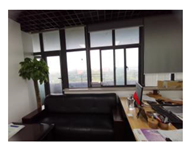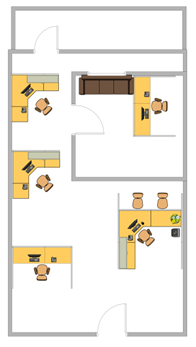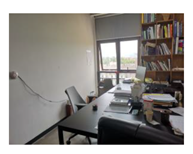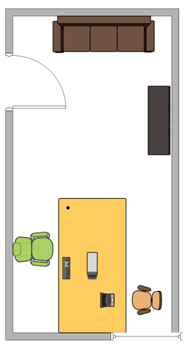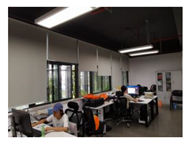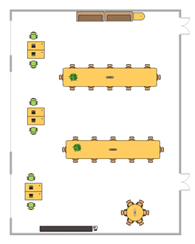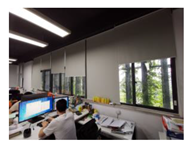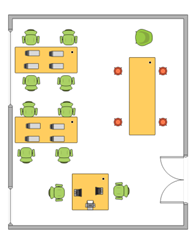Abstract
The manual operation of manual shades plays a significant role in actual building performance. The characteristics of the use of shade and the reasons behind it in a green office building in China have been investigated in this paper. A questionnaire survey with 23 questions was designed and a total of 146 occupants in an office building were invited to take part in the survey. Statistical tests and approaches including non-parametric correlation, cross-tabulation, correspondence analysis and clustering were used to identify shade use patterns and their relation with contextual factors. The results show that sitting closer to windows does not necessarily increase shade actions and most shade raise occurs upon arrival and in the morning while most shade-lowering actions appear at noon and in the afternoon. Two and six clusters were revealed by clustering, respectively, for the time of raising and lowering actions. Regarding the relationship between raising and lowering time, three behavior patterns were identified by correspondence analysis. The first group of occupants typically raise the shades upon arrival or in the morning and lower them in the afternoon. The second group has a tendency to lower the shades upon arrival or in the morning and raise them at noon. The last group often raises the shades upon arrival, lowers them at noon or departure, and occasionally raises them again at departure. Given the current situation of light and shade use, daylight, occupancy and shade-based lighting control have the potential for reducing the lighting energy.
1. Introduction
The building sector consumes a large amount of energy and contributes to substantial greenhouse gas emissions [,]. To reduce building energy consumption, passive building strategies are widely used in green buildings in China [], such as external wall and roof insulations [], high energy-efficient windows [,] and solar shading devices [,]. Most of these measures do not rely on the occupants’ operation, while some highly depend on the use of occupants such as manual shading devices.
Manual shades are widely used in hot summer and cold winter zones in China due to their lower initial and maintenance costs and higher flexibility with control compared to motorized or automated ones. The effectiveness of manual shades is highly dependent on the occupants’ operation. Previous research showed that manual shades were not as highly energy efficient as the designers’ expectations during the building design stage []. For example, manual shades are usually assumed to be efficiently operated by occupants according to solar radiation in summer (shades are lowered to block the solar penetration when solar radiation exceeds a predefined threshold) in order to optimize energy and daylight performance. However, field measurements show that occupants do not operate shades in a machine-like manner and there is actually not a determined threshold over which manual shade actions occur. In reality, occupants adjust shades in a stochastic manner in terms of both frequency of shade action and underlying reasons [,,]. Therefore, there is a need to have a deep understanding of how and why occupants interact with manual shades (not automated or motorized) in green buildings, in order to better evaluate the effectiveness of passive measures used in green buildings.
The earliest research on shading adjustment behavior can be traced back to the study by Rubin and others in 1978 []. To explore the rules of shading adjustment behavior, Rubin and others conducted experimental research on more than 700 offices with shading blinds in a building. The paper revealed notable differences in the shading conditions of offices with different orientations. For over forty years, scholars have extensively studied the impact of various factors on shading adjustment behavior, gradually forming a consensus on key factors and are continuously attempting to refine the predictive model of shading behavior.
Predicting the building occupants’ control preferences and actions have become increasingly important to help understand building performance and energy demands, and to further develop extant building designs and systems []. Many mechanisms that govern occupant behaviors are stochastic in nature and form complex relationships with many physical, psychological and physiological factors. Recent research by Abdelwahab Sahar et al. also indicates that shading adjustment behavior is influenced by cultural factors []. Whilst efforts that have been dedicated to predicting preferences and control behaviors that are motivated by physical factors (e.g., daylight, sunlight, heating and ventilation) are progressing, the role that non-physical motives have on occupant behaviors is still not well understood [].
Although field measurements have been conducted to monitor shade behaviors [,,], they are insufficient to reveal the underlying reasons for shade actions. This is because the reported solar threshold for triggering a shade-closing action varies largely. For example, in Inkarojrit’s study [], manual blinds were not typically closed when vertical solar radiation on windows is less than 13 W/m2, while Mahdavi’s research [] shows that the blind closure rate increases when vertical solar radiation is 150–200 W/m2. The difference between these thresholds indicates the different reasons for the occupants’ shade actions. Hence, apart from field measurements, comprehensive questionnaire surveys are necessary to create an opportunity to address both of these issues simultaneously. Shade-related lighting survey studies have been reported. For example, research by Hirning et al. [] discussed the discomfort of glare from windows under tropical skies. A similar study by Moscoso et al. [] reported a questionnaire survey of lighting environment satisfaction. However, shade use patterns and triggering reasons were not investigated. To the best of the authors’ knowledge, there is no questionnaire study focusing on the use of manual shades in green buildings in hot summer and cold winter zones, which motivates the current study.
2. Methodology
The main purpose of this paper is to investigate shade use patterns and underlying reasons for shade actions in green buildings. The survey is divided into three sections. The first section is about the participants’ background information. The second section focuses on the occupants’ shade use patterns and the last one tries to understand the reasons why occupants operate shades. A total of 23 questions were designed and 146 occupants in a typical green office building (see Figure 1a) in Ningbo City in China were invited to take part in the survey. It is a 9-floor building with a building area of 12,461 m2 and is the first three-star certified green building (the highest level in China) in this city. Table 1 shows the specific information for some typical offices in this building, including the office layouts and photos of them. Manually operated top–down roller shades (see Figure 1b) were used in this building as a passive energy-saving measure. The height of the windows on the north facade and south facade is 2.6 m, and the height of the windows on the west facade and east facade is 2.1 m. The material of the roller shades is fabric, capable of providing shading within a range of 0% to 100%. For built-in roller shades, the shading performance is described by the ability of the shading devices to block shortwave and longwave solar radiation. According to the data provided by the manufacturer, the shading reflects more than 0.67 of the shortwave radiation, and approximately 0.10 of the longwave radiation, with an emissivity of about 0.90. The whole survey was presented in Appendix A. To quantify the occupants’ behavior and make the comparison available, Likert scale questions were designed, and statistical tests and approaches were used to analyze the answers. More detailed information is described in the following sections.
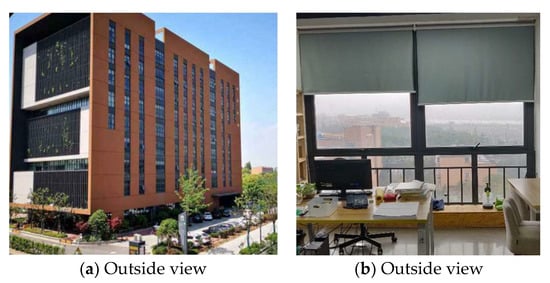
Figure 1.
The photo of the green building and manual shades used in this building.

Table 1.
The floor plans of the offices and the locations of shades.
2.1. Roadmap
The study is a questionnaire-based research. Firstly, it is necessary to choose the target participants for the questionnaire survey. We selected a three-star certified green office building in Ningbo, where the occupants include professionals from the construction industry and those from other industries. Based on the survey subjects and the objective environment of the office building, the questionnaire was designed. During the preparation of the interviews and the questionnaire, questions were simplified and presented in a simple way to encourage people to participate. After collecting the questionnaire survey data, the data was analyzed in various ways, such as cross-tabulation, correspondence analysis, and cluster analysis. Lastly, analyze the characteristics and reasons for manual shade use and draw conclusions. The roadmap is depicted in Figure 2.
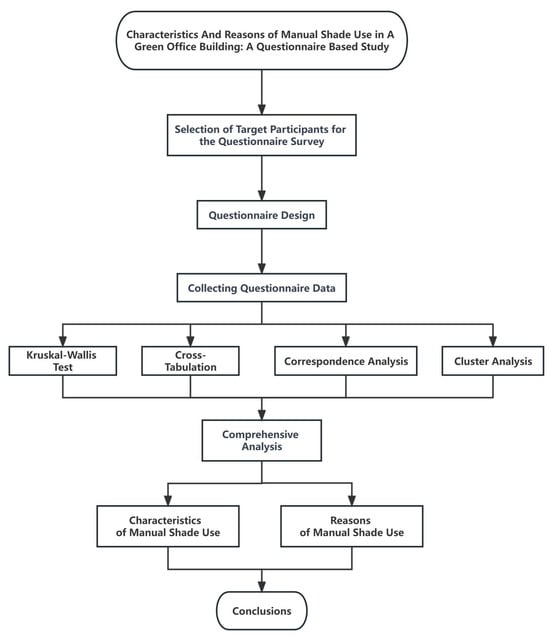
Figure 2.
The roadmap of the research.
2.2. Questionnaire Design
The questionnaire contains a total of 23 questions, organized into three parts. The first part comprises questions about the occupants’ basic information, such as gender, daily office working hours and satisfaction with their office seats. The second part involves inquiries about shading adjustment characteristics, including the frequency of using shading, the timing of adjusting shading and the usual shading position. The third part focuses on reasons for adjusting shading, such as the frequency of lowering shading to reduce the glare. The questionnaire provides a comprehensive approach to collecting data on the occupants’ shading characteristics and reasons from multiple perspectives. It employs simple yet clear language to facilitate a better understanding and accurate communication for survey participants.
2.3. Likert Scale Questions and Kruskal–Wallis Test
To understand how often occupants interact with shades and the frequency of possible reasons for shade actions, the Likert scale questions were used, since it offers a range of answer options from either end of the spectrum for the respondents to choose from. In this paper, most questions are designed on a 5-point Likert scale for satisfaction and frequency quantification (e.g., frequency-related questions have a 5-point scale from never, seldom, sometimes, often to very often, corresponding to a scale of 1 to 5). Due to the fact that the Likert scale is discrete and does not follow a normal distribution, ANOVA analysis is not suitable for such kind of data. Therefore, the non-parametric statistical Kruskal–Wallis test was considered to investigate whether there is a significant difference between the causes of shade adjustment. In addition, the non-parametric Spearman correlation analysis was conducted to reveal the relationship between questions. Employing these methods for research is both highly innovative and remarkably effective.
2.4. Cross-Tabulation
Cross-tabulation, also known as a contingency table, is a method used in qualitative research. It is commonly utilized in the analysis of survey results to seek out relationships and interactions between two variables by laying each variable out on a table. It is computed along with the Chi-square test, which was used to determine whether there is a significant difference between expected frequencies and the observed frequencies in one or more categories. This test can be expressed as:
where O is the observed value and E is the expected value in cross-tabulation.
This test helps identify if the variables of the study are independent or related to each other. The test is less accurate for small samples (less than 5 samples). Thus, the following analysis based on cross-tabulation grouped some categories into one category to make sure the sample size in each group is larger than 5.
2.5. Correspondence Analysis
Correspondence analysis (CA) is a multivariate statistical tool used to visualize and interpret data dependencies. It is an unsupervised approach for the study of associations between variables by the construction of low-dimensional projection space. It was used to quantify nominal (categorical) variables (e.g., five categorical times of shade actions in this paper) by assigning numerical values to the cases and categories so that cases in the same category are close together and those in different categories are far apart. In CA, variables are described in a way that the sum of the distances from the points to their centroid (also called “total inertia”) is proportional to the value of the Chi-square statistic. In this sense, CA decomposes the overall Chi-square statistic. A correspondence map is generated by CA and, on this map, the distance between the two categories is a measure of their similarity []. CA analysis was conducted to explore the hidden relationships between shade behavior and other variables. The formula for the calculation of CA of a table can be expressed as:
where , and are the row, column and total sum of the original table, respectively. and are the projections of the i-th column and j-th row vectors, respectively, on axis r. is the eigenvalue associated with factorial axis r and k is the number of factorial axes.
2.6. Cluster Analysis
Cluster analysis is a statistical technique used to divide a set of observations into different groups/clusters. In each cluster, observations are close to each other. Similarity and dissimilarity are represented by the distance between various observations. In this paper, the k-means clustering algorithm was used to identify potential shade behavior patterns. The optimal number of clusters was estimated via gap statistic techniques.
where n is the sample size, k is the number of clusters being evaluated, and Wk is the pooled within-cluster dispersion measurement and can be calculated as:
where nr is the number of data points in cluster r, and Dr is the sum of the pairwise distances for all points in cluster r. The expected value was calculated by Monte Carlo sampling from a reference distribution, and was computed from the sample data.
3. Result and Discussion
3.1. Background Information
A total of 146 occupants participated in the questionnaire survey, of which 79 (54.11%) were female and 67 (45.89%) were male. A total of 82 occupants (56.16%) work in south-facing offices, 35 in north-facing offices and 16 and 13 occupants in east- and west-facing rooms. The low percentage of occupants in east and west rooms is mainly due to the fact that the long axis of most office buildings is facing south, with most rooms in south and north directions. Most occupants (65.76% see Figure 3) work for more than 6 h in the office space and 21.23% for 4–6 h. Only about 13% of occupants stay in office space for less than 4 h. Shared office spaces are more popular in this region, with 78.08% occupants in shared spaces and 21.92% in private spaces. About half of the occupants (51.35%) are less than 30 years old, 44% of the occupants are between 30 and 50 and only less than 5% of occupants are over 50.
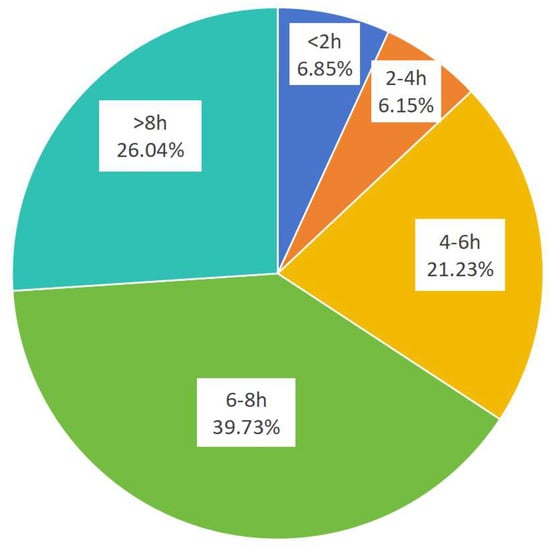
Figure 3.
Time spent in office space every working day.
3.2. Seating Position and Satisfaction
Regarding the seating position (see Figure 4), about half of the occupants sit next to windows (windows on the left/right side), and 21.92% of the occupants face windows. The remaining three parts (face away windows, next to external walls or internal walls) account for 27.39%. The seating position relative to the window impacts the occupants’ satisfaction, as can be seen in Figure 5.
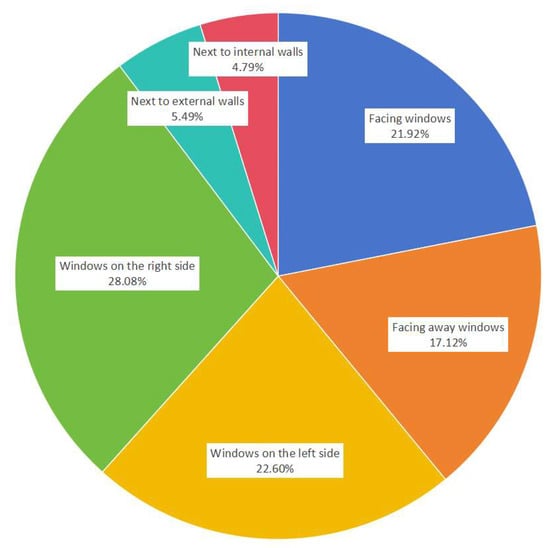
Figure 4.
Seating position.
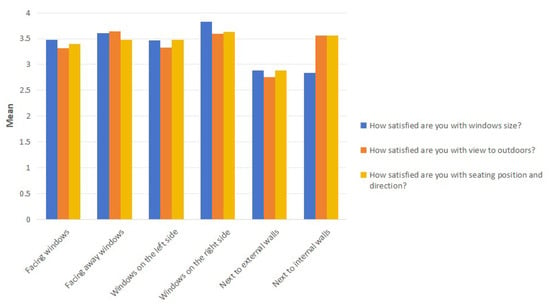
Figure 5.
Satisfaction levels based on seating position relative to windows.
Most seating positions result in an average level that approaches satisfaction (corresponding to Likert scale 4), except for sitting next to external walls where occupants experienced the lowest satisfaction level. An interesting finding is that seating positions next to internal walls have almost the same level of satisfaction. For the distance from seating position to the window (see Figure 6), 39.04% of occupants sit next to windows (<1 m), 46.58% sit near windows (1–3 m) and 14.38% sit away from windows (>3 m). The distance to windows has little influence on the occupants’ satisfaction (see Figure 7), with view and seating position having a little improvement in the satisfaction levels of occupant next to windows.

Figure 6.
Distance of seating position from windows.
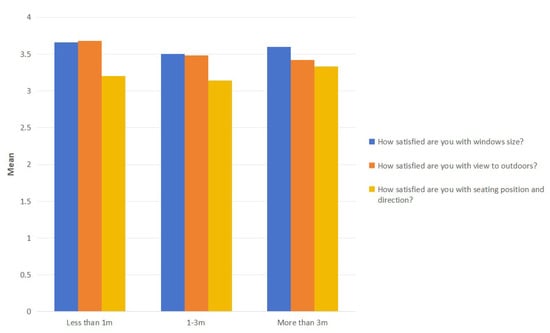
Figure 7.
Satisfaction levels based on distance from windows.
3.3. Frequency of Shade Adjustment
Among the 146 occupants, 23.97% (35/146) of occupants never operate shades and more than 75% (a total of 111) of occupants use shades (see Table 2). The following analysis focuses on shade use patterns and the underlying reasons, and thus, occupants who never adjusted the shades were excluded since they did not answer the following questions. The results show that 21.92% of occupants operate shades more than once a day and the same number of occupants adjust shades less than once a day but more than once a week, while 17.81% for less than once a week. Only 14.38% of occupants operate shades less than once a month. In general, these five percentage values for the five categories do not differ largely, indicating that the frequency of the occupants’ shade actions differs largely. In other words, occupant diversity on shade action frequency is significant. To further investigate if there is a difference among the four orientations, these five categories were grouped into two categories (group 1 includes never, less than once a month and less than once a week representing rare shade use while group 2 includes the remaining two representing the frequent shade uses) to make sure the sample size is more than five in each category. The cross-tabulation was calculated with the Chi-square test and the result shows that there is no significant difference (p value is 0.888) in shade use frequency between different orientations.

Table 2.
Frequency of shade action.
In addition, the cross-tabulation between shade use frequency and distance from windows was also calculated. The number of occupants sitting away from windows is almost the same between rarely and frequently operate shades, while for those who sit close to windows, the number who frequently operate shades is more than two times that of rarely using shades. The Chi-square test shows that the distance from windows influences the occupants’ shade use frequency (p value is 0.027). Occupants who sit near windows tend to interact with shades more frequently than those away from windows. This is because it is more convenient for them to operate shades if sitting next to windows.
The reasons why some occupants never adjust shades are illustrated in Table 3. It shows that the main reason (accounts for 48.57% of the 35 occupants) is they feel visually comfortable and thus, there is no need to adjust them. A total of 20% of the 35 occupants sit far away from windows and they think shades should be adjusted by others next to the windows. Less than 10% of the 35 occupants experienced broken shades and 22.86% reported other reasons. According to the answers, better indoor visual conditions help reduce shade actions and thus, there is a potential to reduce the uncertainty of cooling, heating and lighting energy consumption due to the stochastic manual shade control by maintaining comfortable indoor visual conditions.

Table 3.
Reasons for never using shades.
In addition, a non-parametric correlation analysis (Spearman coefficient, which is suitable for non-normal data) was conducted to examine if the distance from windows impacts shade use frequency. Results show that there is no statistically significant correlation, indicating occupants sitting closer to windows do not necessarily increase shade actions.
3.4. Time of Shade Adjustment
It can be seen from Figure 8 that the time for occupants to raise and lower shades is significantly different. Most shade raise occurs upon arrival and in the morning and most shade-lowering actions appear at noon and in the afternoon. This trend is similar among different orientations (see Figure 9). Therefore, there is a significant difference in the time of shade raise and lowering actions and the modeling of shade actions needs to consider this difference.
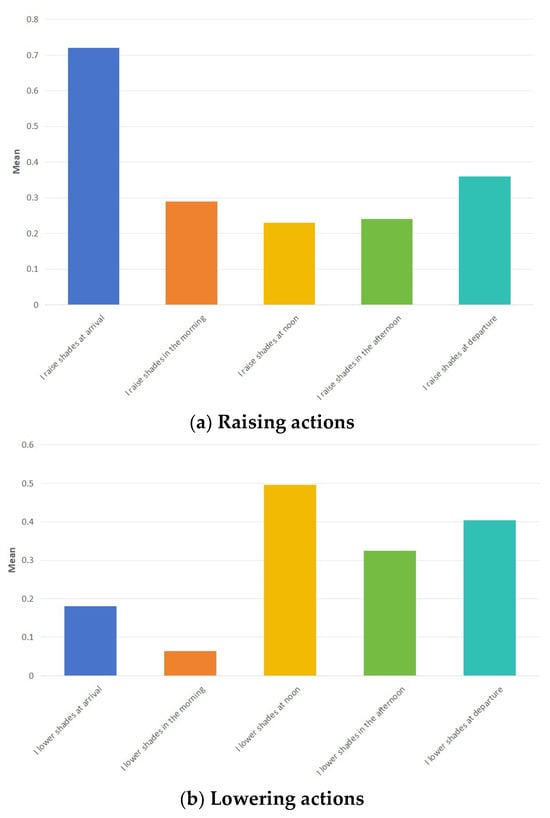
Figure 8.
Time of shade actions.
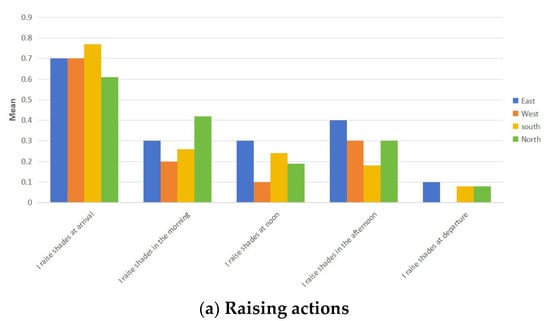
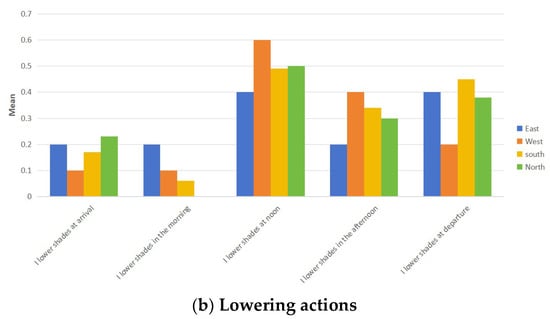
Figure 9.
Time of shade actions in different orientations.
To better understand the potential relationship between shade actions, correspondence analysis was conducted. The results show the first two dimensions account for 89.5% of inertia (dimension 1 accounts for 68.3% and dimension 2 accounts for 21.2%), and thus, these two dimensions were kept based on the criteria of the percentage of explained variance over 70%, and the percentage of explained variance by each dimension over 20% []. Dimensions 1 and 2 are presented in the horizontal and vertical axis in Figure 10, respectively, and the association of column and row points by a correspondence map is illustrated graphically to help visualize the relationship between the two variables (time of raising and lowering action). It shows that three behavior patterns can be grouped with the first group of occupants raising shades upon arrival or in the morning and lower shades in the afternoon. The second group tends to lower shades upon arrival or in the morning and raise them at noon. The last group tends to raise shades upon arrival and lower them at noon or departure, and sometimes raise them at departure.
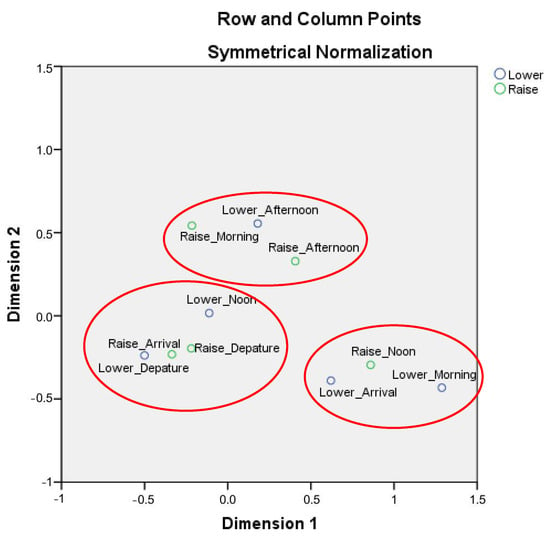
Figure 10.
CA for time of raising and lowering actions.
Clustering shows the optimal number of clusters for the time of raising action is two, which is shown in Figure 11a. Since there are five variables for the time of raising action (upon arrival, in the morning, at noon, in the afternoon and at departure), Figure 11b gives the principal component analysis, which was used to project the five variables into two main components to display the two clusters on a two-dimensional plane. The first component represents 34.9% of the original information while the second component represents 20.6%. The two cluster centers are listed in Table 4. It shows that the first center (first group) represents occupants with raising action at arrival, while the second center (second group) represents raising action during the presence in the office (after arrival). In Figure 12, the horizontal axis corresponds to the occupants (ranging from 1 to 141) ID numbers from survey participants, while the vertical axis represents the times of shade-raising actions; however, due to the large number of IDs, text overlap is unavoidable. But it does not affect the interpretation of the figures or the understanding of the article’s narrative. Figure 12 shows the cluster dendrogram, with 71 occupants in the first group and 40 occupants in the second, indicating most occupants raise shades upon arrival.
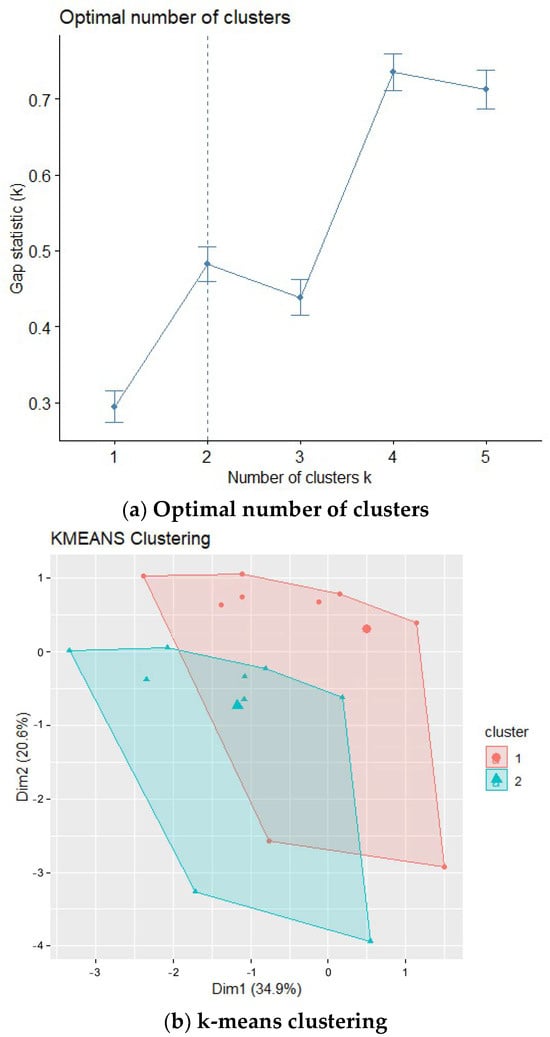
Figure 11.
Two clusters of time of raising action.

Table 4.
Cluster centers for time of raising action.
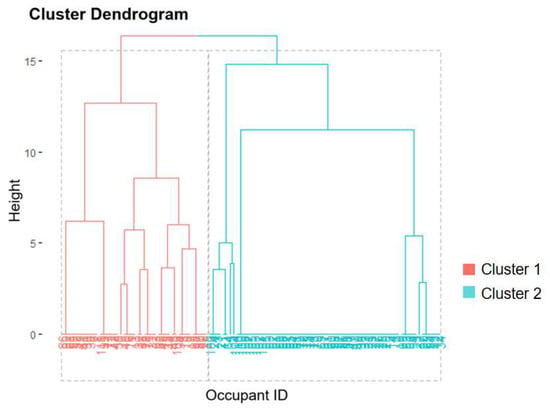
Figure 12.
Cluster dendrogram of time of raising action.
Consistent with the above situation, the horizontal axis of Figure 13 consists of the ID numbers of the 141 occupants. Due to the large number of IDs, text overlap has also occurred, but it does not hinder the continuation of the research. Similarly, six clusters were identified for the lowering action, as can be seen in Table 5 and Figure 13. The first group of occupants lowers the shades mainly in the afternoon, the second in the morning, the third at noon, the fourth at departure, the fifth both upon arrival and departure and the last group at noon and in the afternoon. Thus, the lowering action occurs with great diversity.

Figure 13.
Cluster dendrogram of time of lowering action.

Table 5.
Cluster centers for time of lowering action.
3.5. Which Shade to Be Adjusted?
For office spaces with the width of a window being larger than 1.5 m, multiple top–down roller shades are often installed side by side to cover the whole large window. According to the survey (see Figure 14), only 8.11% of the occupants have only one shade to operate in their office space, indicating that the majority of office spaces are equipped with multiple shades. Therefore, it is important to understand whether occupants operate these shades in the same space in similar patterns. The survey shows that about half of the occupants adjust the shades that have an influence on them (e.g., the shade leads to glare problems) and one-third of the occupants adjust the closest shade. And only 9.01% of the occupants operate each shade in similar patterns. That means most of the occupants adjust different shades in different patterns and it is more likely for them to operate shades that are close to them or have a direct impact on them. Thus, for modeling shade behavior, it is essential to consider the difference between different shades.
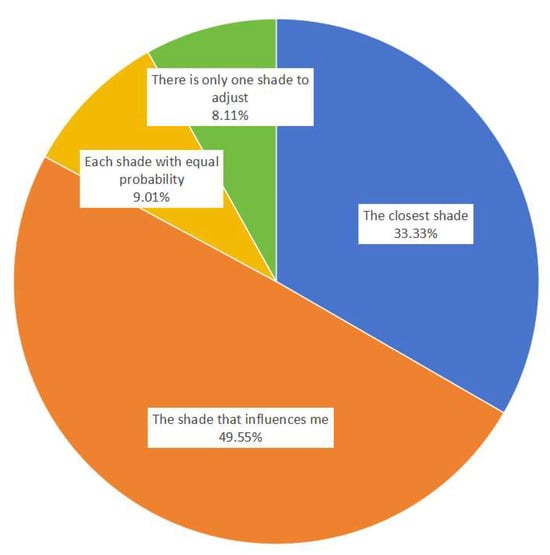
Figure 14.
Which shade do you usually adjust?
3.6. Preferred Shade Positions
For the preferred shade positions (Figure 15), the Kruskal–Wallis test shows that the difference in frequency of shades at the five shade positions is significant (p value is less than 0.05, and the null hypothesis should be rejected) between 100% open and 100% closed, 50% open and 100% closed, 25% open and 100% closed, 100% open and 25% open, 50% open and 25% open and 75% open and 25% open. And there is no significant difference among 100% open, 75% open and 50% open. In addition, these three positions were preferred by occupants, indicating a higher probability for occupants to leave shades more than half open.
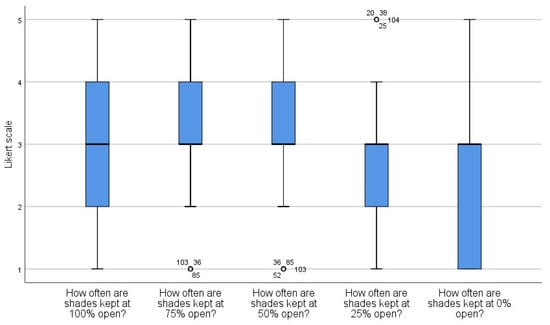
Figure 15.
Box plot of the frequency of occurrence of the five shade positions.
3.7. Reasons for Shade Actions
For the lowering action, the Kruskal–Wallis test shows that the difference in frequency of shade action caused by the five reasons is significant (p value is less than 0.05, and the null hypothesis should be rejected) between the first and third reasons, the second and third reasons, the second and fifth reasons, the first and fifth reasons and the fourth and fifth reasons (see Figure 16). By calculating the mean Likert scale of lowering reasons, it was found that the first, second and fourth reasons were the main reason for the lowering action and the second reason (reducing sunlight on the work plane/computer screen and daylight glare) occurs most frequently, followed by reducing solar heat gain and adjusting room light uniformity. Protecting personal privacy is ranked as the least frequent reason, which may be explained by the fact that office buildings require less privacy compared to residential buildings.
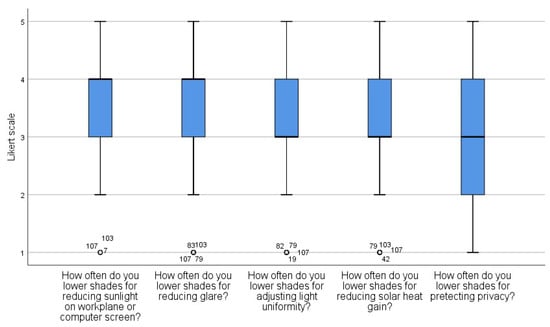
Figure 16.
Box plot of the frequency of occurrence of the five shade-lowering reasons.
Similarly, the shade-raising action was also studied with the Kruskal–Wallis test. It was found that the difference in frequency of shade action caused by the five reasons is significant (p value is less than 0.05, and the null hypothesis should be rejected) between the first and second reasons and the first and fourth reasons (see Figure 17). And increasing room brightness was the main reason for retracting shades, followed by enjoying the sunlight and adjusting room light uniformity, and closing windows and having a view to outdoors were the least frequent reasons. Therefore, occupants mainly raise shades to increase brightness and warm indoor spaces.
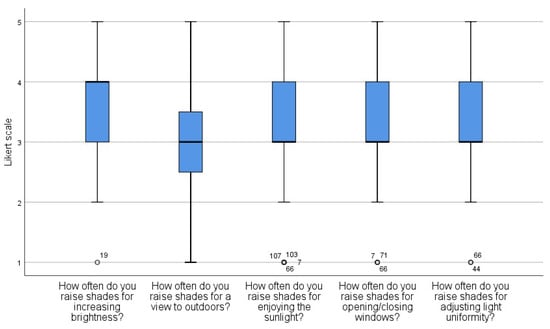
Figure 17.
Box plot of the frequency of occurrence of the five shade-raising reasons.
CA and cluster analysis were conducted to find if there is a correlation between raising/lowering reasons and between individuals. No significant correlation was found and only one cluster was grouped; thus, no clear pattern for the relationship among shade reasons was identified and the occupants’ reasons for shade action did not differ significantly.
3.8. Shade Position vs. Reasons
CA was also conducted to determine if there is a relationship between how often occupants keep shades at 100% open and the frequency of raising shades for increasing brightness (see Figure 18). The Chi-square test is 27.669, with a p value of 0.034, indicating that there is a relationship between the two variables. It can be seen that there is a similar trend for the two variables. For example, those who always raise shades for better brightness are more likely to leave shades 100% open. Similar analysis was conducted for the two variables “how often do you raise shades for increasing brightness” and “how often are shades kept at 0% open”. The Chi-square test is 35.657, with a p value of 0.003, indicating a significant correlation. The almost opposite trend was observed with “very often” for increasing brightness close to “never” keeping shades at 0% open. This means that those who raise shades frequently for increasing brightness more frequently leave shades fully open and less frequently fully closed.
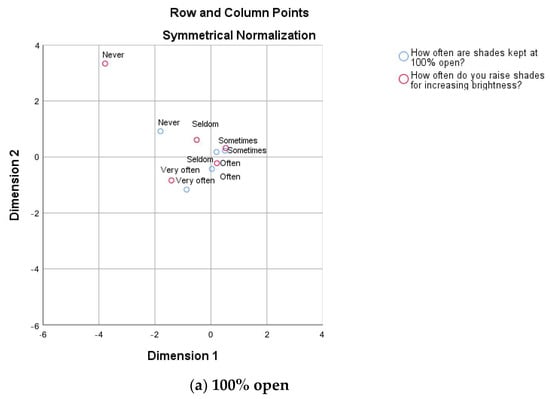
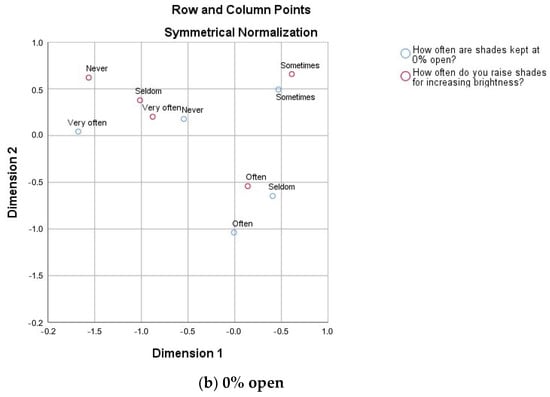
Figure 18.
CA for shade use for increasing brightness and shade position.
3.9. Use of Artificial Lights
The use of artificial lights was also investigated, and the results are shown in Figure 19a. A total of 8.11% of occupants rarely use lights and thus, lighting energy savings from these office spaces are marginal. Most occupants (about 60%) use daylight to offset lighting energy consumption by turning off lights when daylight is sufficient. Thus, daylight-based lighting control is suitable for these occupants and more efficient than manual light switch-off actions. A total of 28.83% of occupants leave lights on during office hours as long as the office space is occupied, indicating daylight is not considered by these occupants. A small number of occupants (3.6%) keep lights always on even if occupants are absent. This group of occupants uses more lighting energy than other occupants and occupancy-based lighting control is applicable for them. Daylight use patterns are illustrated in Figure 19b. It shows a large number of occupants (40.54%) often or very often use daylight to offset lighting energy use. A total of 38.74% of occupants sometimes use daylight while about 20% rarely or never use daylight.
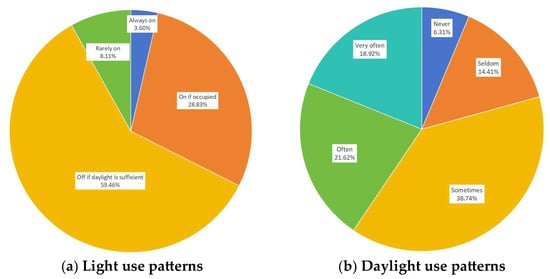
Figure 19.
Light and daylight use patterns.
CA was also conducted to check whether there is a correlation between light use and shade adjustment frequency. The Chi-square shows no statistically significant correlation, indicating lighting use is independent of shade use, while CA for light use and daylight use show there is a correlation. The large circle in Figure 20 shows that those who often use daylight rarely turn on lights or often turn off lights if daylight is sufficient. Due to the lack of correlation between light use and shade use, lighting energy use can be further reduced by better shade control. Given the current situation of light and shade use, daylight, occupancy and shade-based lighting control have the potential to reduce lighting energy.
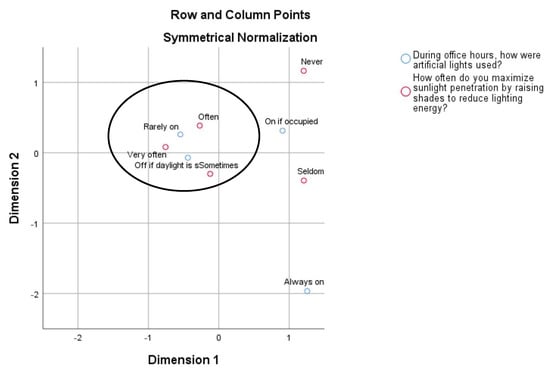
Figure 20.
CA for Light use patterns and daylight use patterns.
4. Conclusions
This paper investigates shade use patterns in a typical green building in the hot summer and cold winter zones in China and the underlying reasons for shade actions. A questionnaire survey with 23 questions was designed and a total of 146 occupants were invited to take part in the survey. Statistical tests and approaches were used to analyze the answers. The main conclusions about characteristics and reasons behind manual shade use are summarized below:
- There is significant diversity in the frequency of shade adjustment among occupants. The cross-tabulation was calculated with the Chi-square test and the results show that there is no significant difference (p value is 0.888) in shade use frequency between different orientations. Non-parametric correlation analysis shows that occupants sitting closer to windows do not necessarily increase shade actions. Thus, automated shade systems may be introduced to efficiently operate shades in response to changing outdoor conditions.
- Most shade raise occurs upon arrival and in the morning and most shade-lowering actions appear at noon and in the afternoon. This trend is similar among different orientations. Two and six clusters were revealed by clustering, respectively, for the time of raising and lowering actions. Regarding the relationship between raising and lowering time, three behavior patterns were identified by correspondence analysis.
- Most occupants adjust different shades in different patterns, and it is more likely for them to operate shades that are close to them or have a direct impact on them. Thus, for modeling shade behavior, it is essential to consider the difference between different shades.
- There is a higher probability for occupants to leave shades more than half open than closed. This means summer solar heat gain through windows may increase cooling loads and improvement strategies need to be further developed.
- It was found that reducing sunlight on work plane/computer screens and daylight glare and reducing solar heat gain are the main reasons for shade-lowering actions. And increasing room brightness was the main reason for retracting shades, followed by enjoying sunlight.
- Those who raise shades frequently to increase the brightness more frequently leave shades fully open and less frequently fully closed. Those who often use daylight rarely turn on lights or often turn off lights if daylight is sufficient. Given the current situation of light and shade use, daylight, occupancy and shade-based lighting control have the potential to reduce lighting energy.
- This paper selected a typical green office building in Ningbo as the experimental subject, which possesses certain representativeness and foresight. Nevertheless, there are numerous office building types, diverse office environments in varying lighting and thermal conditions and a multitude of different shading options. Due to the limited sample size, this research has limitations in terms of office building types, shading types and geographical scope. And in the future, more climate types and different types of office buildings can be studied to verify the general applicability of the conclusions obtained in this paper. For example, most occupants are more likely to operate shades that are close to them or have a direct impact on them. Therefore, it is necessary to study how different types of architectural shading affect occupants. The shading adjustment behavior in buildings is stochastic, and it is hoped that similar research can point out more energy-saving shading adjustment modes, while also better guiding the design and construction of buildings.
Author Contributions
Conceptualization, J.Y. (Jian Yao) and R.Z.; methodology, J.Y. (Jian Yao); software, J.Y. (Jinyu Yuan) and J.Y. (Jian Yao); investigation, J.Y. (Jinyu Yuan) and J.Y. (Jian Yao); writing—original draft preparation, J.Y. (Jinyu Yuan); writing—review and editing, J.Y. (Jian Yao) and R.Z.; visualization, J.Y. (Jinyu Yuan) and J.Y. (Jian Yao); supervision, J.Y. (Jian Yao) and R.Z. All authors have read and agreed to the published version of the manuscript.
Funding
This research was funded by the National Natural Science Foundation of China under Grant No. 51878358.
Acknowledgments
This work was supported by the National Natural Science Foundation of China under Grant No. 51878358.
Conflicts of Interest
The authors declare no conflict of interest.
Appendix A. Shade Use Survey
- Gender (male, female)
- In which direction is your room facing? (east, south, west, north)
- Where is your seating position? (Facing windows, Facing away windows, Windows on the left side, Windows on the right side, Next to external walls, Next to internal walls)
- How old are you? (<30, 30–40, 40–50, >50)
- How long do you stay in office space every workday? (<2 h, 2–4 h, 4–6 h, 6–8 h, >8 h)
- Is your office space private or shared? (private, shared)
- What is the distance of your seating position from external walls? (less than 1 m, 1–3 m, More than 3 m)
- How satisfied are you with window size? (very unsatisfied, unsatisfied, neutral, satisfied, very satisfied)
- How satisfied are you with view to outdoors? (very unsatisfied, unsatisfied, neutral, satisfied, very satisfied)
- How satisfied are you with seating position and direction? (very unsatisfied, unsatisfied, neutral, satisfied, very satisfied)
- During office hours, how were artificial lights used? (Always on even if occupants were absent, On if occupants were present, Lights were turned off if daylight was sufficient, Lights were rarely turned on, Lights were never turned on)
- How often do you use shades? If select never, ONLY need to answer the following THREE questions. Else, jump to question 15 (Never, Less than once a month, Less than once a week, Less than once a day, More than once a day)
- What is the reason why you do not adjust shades? (They are broken, I do not sit next to windows and shades are adjusted by others, It is comfortable and there is no need to adjust shades, Other reasons)
- At which position are shades usually kept? (100% open, 75% open, 50% open, 25% open, 0% open)
- Did you experience discomfort caused by shade action by others? (never, seldom, sometimes, often, very often)
- Which shade do you usually adjust? (The closest shade, The shade that influences me, Each shade with equal probability, There is only one shade to adjust)
- Whether does the frequency of shade use increase if manual shades are replaced by motorized ones? (Yes, No)
- Please select the frequency of shade raising actions due to the following reasons:
- (1)
- How often do you raise shades for increasing brightness? (never, seldom, sometimes, often, very often)
- (2)
- How often do you raise shades for a view to outdoors? (never, seldom, sometimes, often, very often)
- (3)
- How often do you raise shades for enjoying the sunlight? (never, seldom, sometimes, often, very often)
- (4)
- How often do you raise shades for opening/closing windows? (never, seldom, sometimes, often, very often)
- (5)
- How often do you raise shades for adjusting light uniformity? (never, seldom, sometimes, often, very often)
- Please select the time of shade raising actions (multiple choices apply):
- (1)
- I raise shades at arrival (Yes, No)
- (2)
- I raise shades in the morning (Yes, No)
- (3)
- I raise shades at noon (Yes, No)
- (4)
- I raise shades in the afternoon (Yes, No)
- (5)
- I raise shades at departure (Yes, No)
- Please select the frequency of shade lowering actions due to the following reasons:
- (1)
- How often do you lower shades for reducing glare? (never, seldom, sometimes, often, very often)
- (2)
- How often do you lower shades for reducing sunlight on work plane or computer screen? (never, seldom, sometimes, often, very often)
- (3)
- How often do you lower shades for reducing solar heat gain? (never, seldom, sometimes, often, very often)
- (4)
- How often do you lower shades for adjusting light uniformity? (never, seldom, sometimes, often, very often)
- (5)
- How often do you lower shades for protecting privacy? (never, seldom, sometimes, often, very often)
- Please select the time of shade raising actions (multiple choices apply):
- (1)
- I lower shades at arrival (Yes, No)
- (2)
- I lower shades in the morning (Yes, No)
- (3)
- I lower shades at noon (Yes, No)
- (4)
- I lower shades in the afternoon (Yes, No)
- (5)
- I lower shades at departure (Yes, No)
- Please select the occurrence of frequency of the following shade position:
- (1)
- How often are shades kept at 100% open? (never, seldom, sometimes, often, very often)
- (2)
- How often are shades kept at 75% open? (never, seldom, sometimes, often, very often)
- (3)
- How often are shades kept at 50% open? (never, seldom, sometimes, often, very often)
- (4)
- How often are shades kept at 25% open? (never, seldom, sometimes, often, very often)
- (5)
- How often are shades kept at 0% open? (never, seldom, sometimes, often, very often)
- How often do you maximize sunlight penetration by raising shades to reduce lighting energy? (never, seldom, sometimes, often, very often)
References
- Jiang, M.P.; Tovey, K. Overcoming barriers to implementation of carbon reduction strategies in large commercial buildings in China. Build. Environ. 2010, 45, 856–864. [Google Scholar] [CrossRef]
- McLeod, R.S.; Hopfe, C.J.; Rezgui, Y. An investigation into recent proposals for a revised definition of zero carbon homes in the UK. Energy Policy 2012, 46, 25–35. [Google Scholar] [CrossRef]
- Sun, F. Achieving suitable thermal performance in residential buildings in different climatic regions of China. Energy Build. 2013, 67, 11–21. [Google Scholar] [CrossRef]
- Yu, J.; Tian, L.; Yang, C.; Xu, X.; Wang, J. Sensitivity analysis of energy performance for high-rise residential envelope in hot summer and cold winter zone of China. Energy Build. 2013, 64, 264–274. [Google Scholar] [CrossRef]
- Zhang, J.; Zhou, N.; Hinge, A.; Feng, W.; Zhang, S. Governance strategies to achieve zero-energy buildings in China. Build. Res. Inf. 2016, 44, 604–618. [Google Scholar] [CrossRef]
- Wang, Z.; Zhang, B.; Li, G. Determinants of energy-saving behavioral intention among residents in Beijing: Extending the theory of planned behavior. J. Renew. Sustain. Energy 2014, 6, 053127. [Google Scholar] [CrossRef]
- Xuan, Y.; Yang, G.; Li, Q.; Mochida, A. Outdoor thermal environment for different urban forms under summer conditions. Build. Simul. 2016, 9, 281–296. [Google Scholar] [CrossRef]
- Yao, J. An investigation into the impact of movable solar shades on energy, indoor thermal and visual comfort improvements. Build. Environ. 2014, 71, 24–32. [Google Scholar] [CrossRef]
- Yao, J. Determining the energy performance of manually controlled solar shades: A stochastic model based co-simulation analysis. Appl. Energy 2014, 127, 64–80. [Google Scholar] [CrossRef]
- Haldi, F.; Robinson, D. Adaptive actions on shading devices in response to local visual stimuli. J. Build. Perform. Simul. 2010, 3, 135–153. [Google Scholar] [CrossRef]
- Sadeghi, S.A.; Karava, P.; Konstantzos, I.; Tzempelikos, A. Occupant interactions with shading and lighting systems using different control interfaces: A pilot field study. Build. Environ. 2016, 97, 177–195. [Google Scholar] [CrossRef]
- Rubin, A.I.; Collins, B.L.; Tibbott, R.L. Window blinds as a potential energy saver: A case study. In NBS Building Science; Series 112; US Department of Commerce, National Bureau of Standards: Gaithersburg, MD, USA, 1978. [Google Scholar]
- Abdelwahab, S.; Rutherford, P.; Mayhoub, M.; Altomonte, S. Sensitivity analysis on the impact of user control on daylight and energy simulations. In Proceedings of the IBPSA-Building Simulation 2019 International Conference, Rome, Italy, 2–4 September 2019. [Google Scholar]
- Sahar, A.; Michael, K.; Mohammed, M. Users’ window preferences and motivations of shading control: Influence of cultural characteristics. Build. Environ. 2023, 240, 110455. [Google Scholar] [CrossRef]
- Heydarian, A. A Systematic Approach to Understand and Model the Impact of Lighting Behavior on Building Energy Consumption through Immersive Virtual Environments; University of Southern California: Los Angeles, CA, USA, 2017. [Google Scholar]
- Reinhart, C.F.; Voss, K. Monitoring manual control of electric lighting and blinds. Light. Res. Technol. 2003, 35, 243–258. [Google Scholar] [CrossRef]
- Gunay, H.B.; O’Brien, W.; Beausoleil-Morrison, I.; Gilani, S. Development and implementation of an adaptive lighting and blinds control algorithm. Build. Environ. 2017, 113, 185–199. [Google Scholar] [CrossRef]
- Inkarojrit, V. Balancing Comfort: Occupants’ Control of Window Blinds in Private Office; University of California, Berkeley: Berkeley, CA, USA, 2015. [Google Scholar]
- Mahdavi, A. Patterns and implications of user control actions in buildings. Indoor Built Environ. 2009, 18, 440–446. [Google Scholar] [CrossRef]
- Hirning, M.B.; Isoardi, G.L.; Garcia-Hansen, V.R. Prediction of discomfort glare from windows under tropical skies. Build. Environ. 2017, 113, 107–120. [Google Scholar] [CrossRef]
- Moscoso, C.; Matusiak, B. Aesthetic perception of a small office with different daylighting systems. Indoor Built Environ. 2018, 27, 1187–1202. [Google Scholar] [CrossRef]
- Higgs, N.T. Practical and Innovative Uses of Correspondence Analysis. J. R. Stat. Soc. Ser. D (Stat.) 1991, 40, 183–194. [Google Scholar] [CrossRef]
Disclaimer/Publisher’s Note: The statements, opinions and data contained in all publications are solely those of the individual author(s) and contributor(s) and not of MDPI and/or the editor(s). MDPI and/or the editor(s) disclaim responsibility for any injury to people or property resulting from any ideas, methods, instructions or products referred to in the content. |
© 2023 by the authors. Licensee MDPI, Basel, Switzerland. This article is an open access article distributed under the terms and conditions of the Creative Commons Attribution (CC BY) license (https://creativecommons.org/licenses/by/4.0/).
